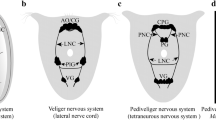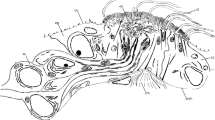Summary
The ultrastructure of the static organ is examined in larvae of Diplosoma macdonaldi, a colonial ascidian, and Styela plicata, a solitary ascidian; the results are similar. As previous workers found, the cell body of a unicellular statocyte lies in the lumen of the sensory vesicle and contains the statolith. A narrow neck connects the cell body to an anchoring foot in the floor of the sensory vesicle. Two previously undescribed sensory endings project into the lumen just to the left of the statocyte, one anterior and one posterior to the neck. A network of fine processes from each ending contacts the statocyte body. It is proposed that movements of the statocyte cell body are detected by these endings. They arise from neurons in the ventral wall of the sensory vesicle that project axons to the visceral ganglion. The placement of the sensory endings may allow discrimination of the directon of statocyte deflection.
Similar content being viewed by others
Abbreviations
- ax :
-
axons
- bb :
-
ciliary basal body
- bl :
-
basal lamina
- c :
-
cilium
- cr :
-
striated ciliary rootlet
- ec :
-
ependymal cells
- en :
-
endoderm
- h :
-
hemocoel
- ly :
-
lysosome
- mv :
-
microvilli
- n :
-
neuron
- nf :
-
neurofilaments
- ns :
-
neck of the statocyte
- sb :
-
statocyte cell body
- sd :
-
sensory dendrite
- sn :
-
sensory neuron
- sp :
-
sensory processes
- stf :
-
statocyte foot
- svl :
-
sensory vesicle lumen
- zo :
-
zonula occludens
References
Cloney RA (1978) Ascidian metamorphosis: Review and analysis. In: Chia F-S, Rice M (eds) Settlement and metamorphosis of marine invertebrate larvae. Elsevier, New York Oxford, pp 255–282
Cloney RA (1979) Larval adhesive organs and metamorphosis in ascidians II. The mechanism of eversion of the papillae of Distaplia occidentalis. Cell Tissue Res 200:453–473
Cloney RA, Florey E (1968) Ultrastructure of cephalopod chromatophore organs. Z Zellforsch 89:250–280
Cloney RA, Torrence SA (1984) Ascidian larvae: Structure and settlement. In: Costlow JD, Tipper RC (eds) Marine biodeterioration: An interdisciplinary study. US Naval Inst, Annapolis, pp 141–148
Crisp DJ (1974) Factors influencing the settlement of marine invertebrate larvae. In: Grant PT, Mackie AM (eds) Chemoreception in marine organisms. Academic Press, New York, pp 177–265
Dilly PN (1961) Electron microscope observations of the receptors in the sensory vesicle of the ascidian tadpole. Nature 191:786–787
Dilly PN (1962) Studies on the receptors in the cerebral vesicle of the ascidian tadpole I. The otolith. Q J Microsc Sci 103:393–398
Eakin RM, Kuda A (1971) Ultrastructure of sensory receptors in ascidian tadpoles. Z Zellforsch 112:287–312
Minganti A (1951) Richerche istochimiche sulla localizzazione del territorio presuntivo degli organi sensoriali nelle larve di Ascidie. Pubbl St Zool Napoli 23:52–57
Minganti A (1957) Inhibition of melanogenesis in Phallusia embryos (ascidians). Acta Embryol Morphol Exp 1:37–47
Peters A, Palay SL, Webster HDF (1970) The fine structure of the nervous system: The cells and their processes. Harper and Row, New York
Torrence SA (1980) The styelid photolith: A compound sense organ in ascidians. Am Zool 20:886
Torrence SA (1983) Ascidian larval nervous system: Anatomy, ultrastructure and metamorphosis. PhD Thesis, U of Washington
Torrence SA, Cloney RA (1981) Rhythmic contraction of the ampullar epidermis during metamorphosis of the ascidian Molgula occidentalis. Cell Tissue Res 216:293–312
Torrence SA, Cloney RA (1983) Ascidian larval nervous system: Primary sensory neurons in adhesive papillae. Zoomorphology 102:111–123
Vorontsova MN, Malakhov VV (1982) Structure of the larval photolith in the ascidian Cnemidocarpa finmarkiensis (Stolidobranchiata, Styelidae). Doklady Akademii Nauk SSSR 264:507–509
Vorontsova MN, Malakhov VV (1984) Anatomy and fine structure of ascidian tadpole larvae Cnemidocarpa finmarkiensis 2. Sense organs. Zool Zh 63:1036–1045
Whittaker JR (1966) An analysis of melanogenesis in differentiating pigment cells of ascidian embryos. Dev Biol 14:1–39
Author information
Authors and Affiliations
Rights and permissions
About this article
Cite this article
Torrence, S.A. Sensory endings of the ascidian static organ (Chordata, Ascidiacea). Zoomorphology 106, 61–66 (1986). https://doi.org/10.1007/BF00312108
Received:
Issue Date:
DOI: https://doi.org/10.1007/BF00312108




